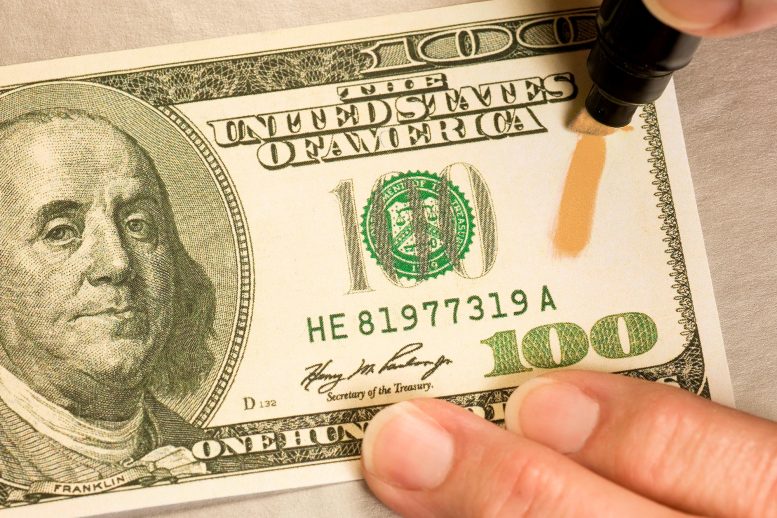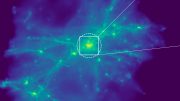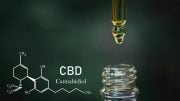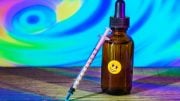
Delving into the chemistry of counterfeit detection pens, this video covers various experimental attempts to modify their reaction with starch. It also discusses the broader context of counterfeit money detection, underscoring the intricacies involved.
Counterfeit detector pens use a starch-iodine reaction to identify fake bills. But could you fool them with chemistry? In today’s episode, we dive into the chemistry of iodine, its color and its clock reactions, all while making a little extra cash on the side.
Video Transcript:
Let’s say that we wanted to fool these counterfeit detection pens for science, how could we make this reaction not happen on normal paper?
Y’all, my search history is a mess.
(subtle groovy music)
I’m telling you, someone’s gonna look at my online purchase history and be like, she’s printing bills and like, I mean, technically I did.
Making counterfeit money is bad and wrong and illegal and hard to do, and if you are looking for a how-to video, this is not it.
Does that work, ACS Legal?
Can we make the video now?
These pens are filled with an iodine solution, usually something like potassium iodine to help the non-polar iodine dissolve in water. If you swipe them on a piece of regular non-currency paper, which contains starch, it leaves behind a dark mark, and that is it.
These pens are just a simple reaction between iodine and starch.
Now, most regular paper like printer paper contains starch.
If you recall our soft bread episode, some of the starches arranged into long strands of glucose molecules called amylose, which can fold into helices.
Inside the pen, iodine and iodide ions come together to form a triiodide complex.
I know, I know, let’s go to the whiteboard.
Okay, I got you.
So iodine is the element, iodide is the ion, and the triiodide complex is three of ’em all together.
Got it?
Great.
I think I got it.
Equilibrium.
This is important because when you run the pen over the paper, these triiodide complexes slip inside the amylose helix and cause a dark purple or brown color.
This is why you can get the same reaction on a starchy food like a potato chip.
So iodine plus starch equals a brown mark on regular paper, but currency paper isn’t regular paper.
It’s actually a mix of fabric fibers and contains no starch.
So when you run the pen over a real bill, there’s no color change because there’s no starch.
Iodine’s color change depends on what it is dissolved in.
As a solid, iodine is kind of a grayish metal with a purple vapor.
If you add a bit of iodine solution into oil, you can see that really pretty kind of violet color.
There’s a world in which that’s purple.
The color we see, of course, is light reflecting off of the molecules.
Some light gets absorbed, moving electrons around in their molecular orbitals, and some light bounces off, and what we see is the light that bounces off.
So if the wavelengths of light that get absorbed change,
the color we see can change as well.
And iodine’s color changes based on its solvent.
For example, when added to water, iodine solutions turn from that sort of purple color into more of a yellow brown color.
This is due in part to the interaction of electrons between the iodine and the water molecules.
Weakly-bound donor acceptor complexes can form between the iodine and the water, and this changes how the electrons respond to incoming light, changing the wavelengths of light that are absorbed, changing the color that we see.
Now, when the iodine solution in the pens reacts with starch molecules on paper, you get this kind of purple-brown color.
And remember how I said that it was likely because of the triiodide complexes slipping into the starch helices?
There’s actually a bit more than just that going on here, and the research into the specifics is still ongoing, because it’s really cool.
So the pens contain a really dilute iodide-iodine solution, which has little to no color.
Now, there are I2 molecules floating around, triiodide complexes and potassium iodide.
And if anything, this whole thing is just like, slightly pale yellow.
But when the triiodide molecules slip inside the amylose helices in starch, I2 molecules tag along with them.
Electrons that absorb incoming light can now easily move back and forth between the I2 and I3 molecules, because they’re right next to each other, changing not just the color of the iodine, but also the intensity.
So now you can get these bright blues and dark browns that we see when we mix starch and iodine.
Various lengths of polyiodine chains inside the amylose helices have been proposed from three to four, like we just talked about, to as high as 160.
So, lots of variability.
A 2022 team investigated and suggested that the short chains might enter the helix and then rearrange, causing longer chains, and also potentially causing changes to the structure of the helix itself.
The interaction also changes based on the length and the structure of the amylose helices, how much water is around, how the starch itself was purified.
There are a lot of things here that might impact exactly what color happens when you run that pen over the paper.
Anyways, this is all cool, but what if we wanna actually stop this interaction from happening?
We can’t pull the iodine outta the pens, so instead, let’s see if we can take a stab at getting the starch out of the paper.
First up, starch is a polymer of sugar molecules, so we could try heat to break that down.
Starch breaks down starting at around 280 degrees Celsius, which is about 536 degrees Fahrenheit.
But my oven only goes to 500, and the ignition temperature paper is around 233 Celsius or 451 Fahrenheit, so I’m gonna try and set my oven to 425 and see if maybe we can break it down a little bit, but without catching it on fire.
(pan bangs)
Don’t try this at home.
I also have a fire professional on hand, just in case.
(container rustling)
(incorrect buzzer dings)
But here’s why biochemistry is my favorite.
Fight me, George.
Enzymes catalyze reactions by lowering their activation energy, and there is an enzyme that catalyzes the breakdown of starch.
Amylase.
Amylase takes that reaction that happens at 233 degrees Celsius and makes it happen closer to about 65 to 75 Celsius, which is way more reasonable.
Now, your spit actually contains a lot of amylase to break down the starches in food.
So what I’m gonna do is I’m gonna take this piece of paper and I’m gonna lick it, no, I’m not.
I’m not gonna do that.
Instead, I’m gonna take this amylase that I ordered from the internet and add 1/2 a teaspoon per gallon of water and simmer our paper in it at about 70 Celsius
or 158 Fahrenheit.
Amylase breaks down starch chains into smaller sugars like maltose and glucose.
There’s bubbles forming at the top, and I actually am wondering if those bubbles are like, little, sugary, I mean for sure it’s ’cause the water is heating up, but like maybe we’re actually breaking down some starch into some sugars there.
Eh, no.
Maybe it worked a little.
No.
(incorrect buzzer dings)
Now, yeast also creates and uses amylase, so if you’d like to do this a much smellier way, you could try that too.
(incorrect buzzer dings)
Alternatively, we could try blocking the iodine from interacting with a starch rather than breaking it down.
Now, we could try and do this physically
with something hydrophobic, like hairspray.
(hairspray whooshes)
Oh-ho-ho-ho, that did not work at all.
It almost made the reaction faster.
Hairspray is a no.
(incorrect buzzer dings)
Or you could try vitamin C.
Vitamin C, AKA, ascorbic acid, reduces iodine into iodide ions, which are basically colorless in solution.
So you get I2, 2I minus.
These hydrogens pop on over here.
Reduction, chemistry.
So we can spray our bill with a little bit of vitamin C dissolved in water, let it dry, and then try out the pen.
Woo.
The vitamin C worked.
(correct buzzer dings)
Can’t catch me now, government mint.
Now, this is how the classic iodine clock reaction works, and I’ve actually never done this experiment before, and it looks really cool, so we’re gonna do it.
I did not come up with this version of the iodine clock reaction, I’m following Nile Red’s version of it, because I haven’t done it before, and I thought this one looked good.
So thanks, Nigel.
Credit where credit is due.
In one beaker, we have water, iodine, and vitamin C.
It’s colorless because that vitamin C means that we have iodide ions.
In the other beaker we have water, hydrogen peroxide, and our old friend, starch.
If we mix the two colorless liquids together, they initially remain colorless, but then bam.
I think my iodine concentration is a little too low.
(bright tone beeps)
(bright subtle music)
Oh, the other one, the one off camera just turned.
There’s hope, there’s hope, there’s hope.
(instructor chuckles)
Bam, they turn into a dark liquid.
This is because there are multiple reactions happening here.
The hydrogen peroxide turns the iodide ions back into I2 or iodine, but as long as there’s vitamin C around, the iodine keeps being reduced back to iodide.
But eventually, the vitamin C runs out, the I2 forms up, comes together with some other I-minus ions to form those triiodide complexes we talked about before.
Those hang out with starch, and bam, color.
So freaking cool.
What was this video about again?
Right, counterfeit money.
Because none of this happens in real currency paper, because there’s no starch in it.
US currency paper is made by Crane & Co.
They were handpicked, no lie, by Paul Revere, to make
the first US currency,
and they’ve just stuck ever since.
The paper also has red and blue colored filaments running through it, making it hard to duplicate, and Crane & Co won’t sell it to you.
But this stuff is some paper that I bought off of Amazon, so you can buy a paper that might already fool a tired, underpaid cashier just trying to finish their shift and check your bill.
Right, it’s definitely a different color from the printer paper.
So there’s printer paper and then Amazon paper.
There’s the real bill, and I don’t think it’s fooling anybody.
I bet they spray it with a little starch for this purpose.
And most real counterfeiters aren’t buying stuff like this.
They’re bleaching small denomination bills to get the right paper, and then printing larger denominations on it.
So these pens are one of the weakest methods of counterfeit detection for a number of reasons.
So was all of this for naught?
I mean, no, the chemistry was worth it.
You learned something, didn’t you?
I did.
I actually haven’t tried this pen on this paper yet.
Also, fun fact, this paper has red and blue filaments running through it.
Like, you can just buy with red and blue fibers in it.
What are they doing?









Be the first to comment on "Outsmarting Counterfeit Detector Pens With Clever Chemistry [Video]"